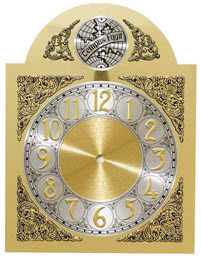On Clock Movements and Motors

Clock activities and motors are the core of any type of timepiece. Clock activities and electric motors may be mechanical or electronic, analog or digital, yet they all identify the angle subtended by each of the hands at any kind of given moment. Having actually existed for centuries in one type or another, these fascinating tools possess a rich history.
Clock electric motors and motions are actually interchangeable terms explaining the exact same thing, though "motion" is a profession term while laypersons have the tendency to choose "electric motor." Originally they were purely mechanical, using the force of a hanging weight or coiled springtime to revolve a flywheel. Pendulums as well as escapements transformed the turning right into an oscillating movement with an especially acquired regularity.
Modern clock motions are digital rather than mechanical. Timing pulses originate from a quartz crystal that shakes at a precise frequency corresponding to the crystal's geometry. Numerical signs up partition the regularity right into conventional timekeeping values.
The fundamental timing pulse is equated right into activity of the hands. Mechanically this is achieved via a network of gears such that the shaft holding the pre-owned turns 6 degrees of arc every second, and the minute-hand shaft and also hour-hand shaft are in turn 60 times slower. Online this activity can be accomplished by converting mathematical values in electronic accumulators directly into shaft setting.
These are the basics of timekeeping. In addition, everything cycles back to the beginning state ultimately, a rolling back to zero, as it were. The majority of frequently this global reset happens every 12 hours, though a 24-hour cycle is often frequently utilized.
Nevertheless, these cycles are according to convention and also can be prolonged out as for preferred. It's simply an issue of configuring the clock motion accordingly. Motors are readily available that carry out weekly as well as monthly cycles with a concomitant positioning of another shaft to direct a fourth hand at the day of the week or day.
Some clock electric motors utilize a 4th hand shaft for showing trend level (a much more challenging calculation but still well within their capacity). Still others are developed to report climate info specifically (i.e., without integrating it right into a watch).
Yet temperature, moisture, and barometric pressure are values obtained from sensors as opposed to derived from intermittent behavior. This implies that weather activities call for added inputs and have to establish restrictions to the values. Dials have to be adjusted as well as hands revolve a part of a cycle.
It needs to currently be clear that clock motions as well as electric motors supply a broad variety of attributes. A few of these are applied in off-the-shelf watches, yet numerous are not. Nonetheless, it is not difficult to locate the activity you desire from an on-line provider as well as construct the desired clocks on your own.
The diameter of most watches is 12 to 14 inches at most, and most of electric motors are made to fit hands as much as the matching maximum length (i.e., minute hands no more compared to 6 or 7 inches). However, some clocks are larger as well as occupy a whole wall! In such an instance, one must make use of a high-torque activity so that the much heavier hands can be rotated with adequate power.
Speaking of power, nearly all of the modern motions operate on batteries varying in dimension from AA to C (and occasionally unique choices). Since replacing the batteries is needed annually or much less frequently, individuals in general locate this appropriate. However, you will certainly locate motors around that plug straight into a wall socket.
Novelties are often incorporated into or affixed to the mechanism. Instances are pendulums (that oscillate for show just) and also chimes (with numerous audio patterns offered). And that completes our short article on clock movements and also motors.
